#hrukgolklo
Explore tagged Tumblr posts
Text
Maniculum Bestiaryposting Results: Miscellaneous Snakes
We have snakes!
Surely y'all know the deal by now, but in case you don't, here's a link: https://maniculum.tumblr.com/bestiaryposting.
To see the entry on which these pictures are based, click here:
To see the one on which next week's will be based, so that you can participate if you like, click here:
Now, art below the cut:
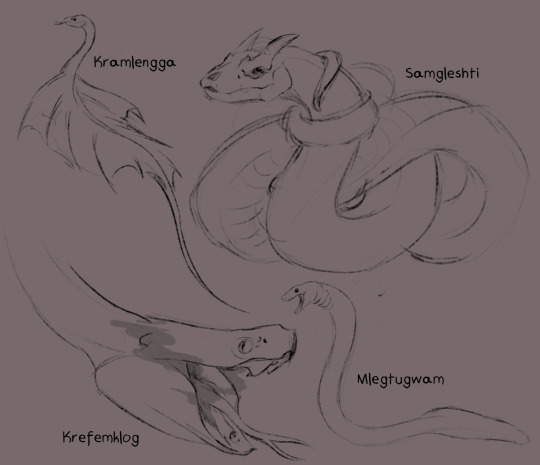
@silverhart-makes-art (link to post here) decided to draw these four snakes. I think they all turned out pretty interesting -- the Kramlengga looks rather elegant, and I think the Mlegtugwam is kind of cute.
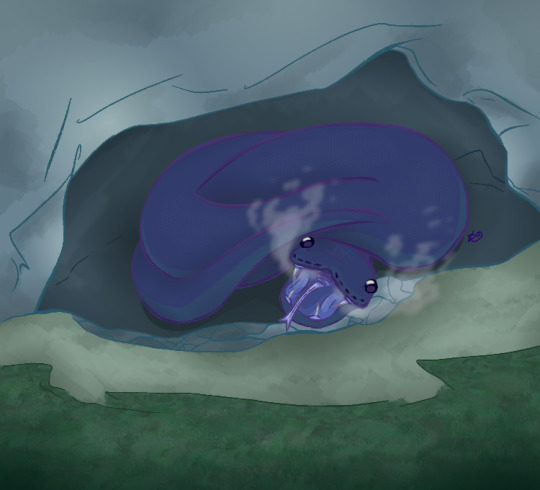
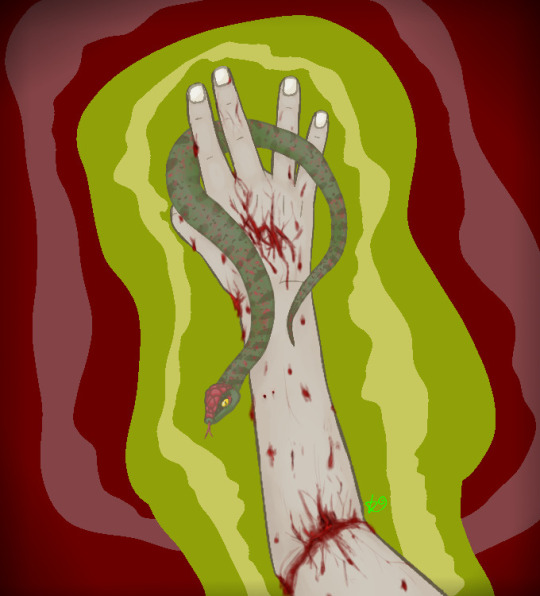
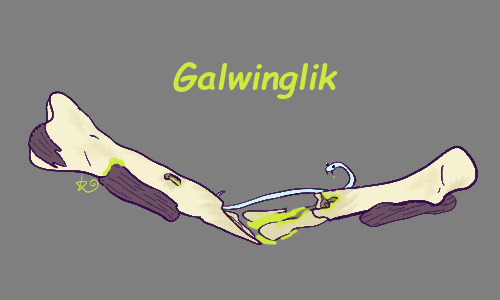
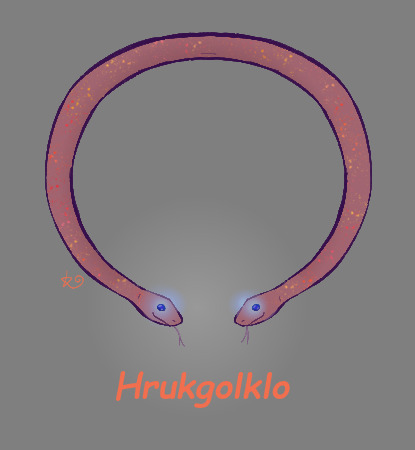
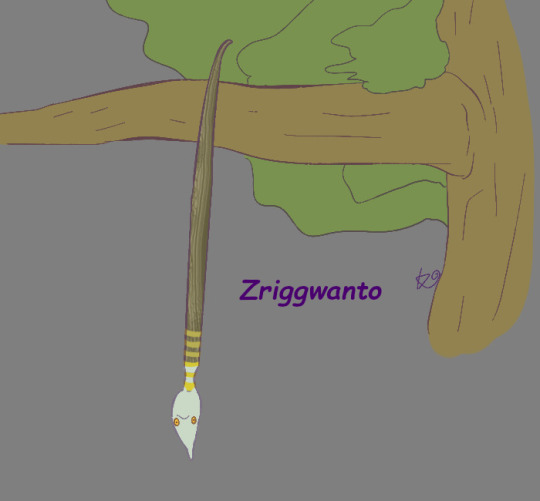
@citrvsdrake (link to post here) has done five separate drawings for five separate snakes. All of them are quite good, actually, but I do think the Mlegtugwam hiding in its cave up at the top there is particularly delightful.

@cheapsweets (link to post here) has drawn all of them. I like them a lot -- the Zriggwanto continues to be very funny visually, and the Krefemklog strikes me as particularly well-rendered here. My favorite, however, is the Thagolgrom entirely because he's in a mazer and I'm fascinated by those. They're a deep research dive waiting to happen to me. (Also, thank you for providing alt text.)
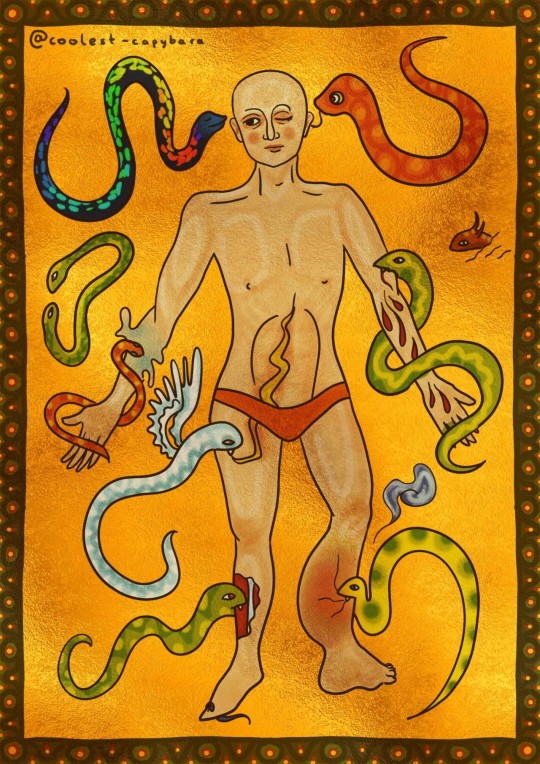
@coolest-capybara (link to post here) had the excellent idea to borrow the concept of the "wound man" diagram for this, so we can see all the dangers of the snakes at once. All of this is fantastic, but I think my favorite is the Samgleshti which has somehow burrowed into the gold-foil background as if it were sand.
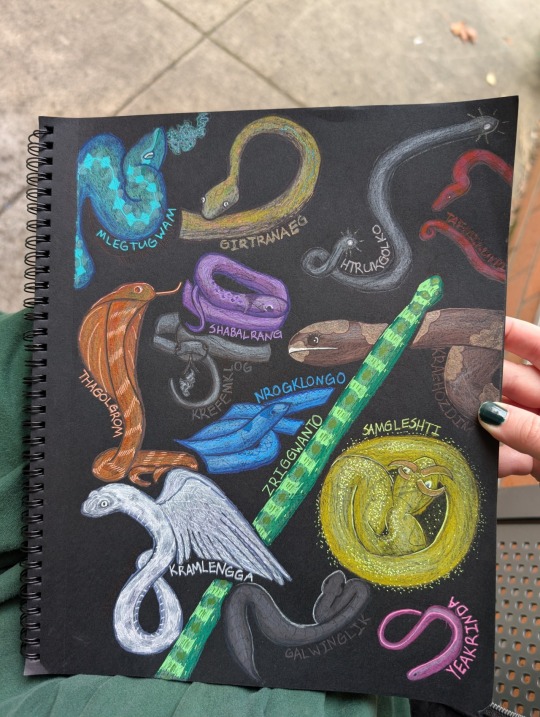
@wendievergreen (link to post here) has done this really cool-looking thing with black paper. I love it. the Thagolgrom and Kramlengga look especially striking. For information about the real-life snakes that inspired all these different depictions, check out the linked post. (Also, thank you for providing alt text.)
All right, let's take a look at the Aberdeen Bestiary.
Mlegtugwam

... so that's not a snake. That is our Default Medieval Wyvern Thing. I think anything serpent-adjacent has a habit of turning into these when our artist is bored.
Anyway, it's an asp. Looks just like one, too. Note that it's plugging its ears, but I'm not sure that defends against being Hit With Stick.
Girtranaeg

Come on. I know we keep finding out new layers of England's shocking lack of animal species, but I know you know what a snake is. I'm 100% sure England has snakes. Adders, at least.
I have to hand this one to the artist, though, they did a good job making the scales look visually interesting.
On the other hand, this is the scitalis, which is not a real snake, so maybe it does look like this. What do I know.
(I'm glossing over a lot of these not just because there are a lot, but also because there really isn't that much more written about them than what we've already read.)
Hrukgolklo

I'm sure at least one of y'all clocked this one, and if nobody did, someone probably just realized when they saw the illustration. This is the amphisbaena, and the above is possibly the most famous illustration of one -- seriously, I see it everywhere.
Which is kind of annoying actually, because again that is not a picture of a snake. There's also this thing going on here, which CheapSweets seemed to reach on their own from first principles -- it's really easy to read the description of the amphisbaena moving in a circle as it rolling along like a hoop snake. You can even see that kind of happening in the illustration, with the head gripping the tail. It comes up in multiple illustrations of the thing.
Now, I've always read it as... when the amphisbaena is crawling along, the heads are right next to each other and moving in the same direction, so the body forms almost a complete circle. I have no idea if a snake could actually do that, but bestiary authors aren't anatomists. Because, like, okay: of all the snakes, the amphisbaena is the least equipped to do the hoop snake thing, because if it grips its tail with its mouth, it's also gripping its other head, which should be more difficult and less comfortable, right?
Sorry, this is something that's bothered me for years.
Oh, also, the amphisbaena is of course fictitious, as is the hoop snake.
Thagolgrom
No illustration for this one, because it's "a kind of asp", so it's rolled into that entry. This is the (as far as I know not real) dissa.
Shabalrang
As above, except this is the appropriately named ypnalis.
Tafmiwukri
This type of asp is called emorrosis. Which... also has a familiar ring to it. I'm tempted to start looking stuff up to see if all of these asps are named after the effects of their venom, but it's past 11pm and I don't have the time.
Krefemklog
This asp is called a prester, and rules over a country of obscene riches far to the east... wait, no, that's a different thing. This kind of prester is just a cool snake.
Kraehozdim

This is the boa. Which threw me, because I thought those were New World snakes. Turns out, though, the genus Eryx is found around the Mediterranean and in various parts of Africa and Asia, so okay then.
Nrogklongo
Another asp with no illustration! This one is called spectaficus, which sounds cool.
Samgleshti
For some reason this one also doesn't have an illustration, which makes me feel cheated. It's the cerastis, which also makes an appearance in the Wonders of the East, though I think they call it corsia or something. Not a real snake, in case anyone wasn't sure about the horns.
Zriggwanto

... huh. Well, okay, that does look like a javelin snake. This one is the jaculus, which I was ready to dismiss as another imaginary thing, but apparently there might be a grain of truth to it? It seems that the boa species Eryx jaculus is so named because of a claim that the ancient Greeks used to throw them at enemy ships during naval battles to cause fear and confusion among the opposing crew. Maybe. I don't have the time to look into the veracity of that one right now.
But how 'bout that, huh?
Kramlengga

You'd think that one of these snakes being distinguished by having wings would have discouraged the artist from putting wings on the rest of them, but... well. See, now they don't have anything neat to do with the illustration for the winged snake.
Anyway, this is the siren. No, not that one, those are separate and turn up in other bestiaries. This is the snake kind of siren. It's also not real, which is a trend in snakes apparently.
Galwinglik

This is the closest to "snake", even if it has a fox head. It is the seps, which is also not real.
Yeakrindra
No illustration for this one. It also didn't get a header; the text just segued right from "seps" to dipsa. Might have been a scribal error somewhere maybe? Anyway, the dipsa is also fictitious.
And... that's all of them.
Goodnight; dream of danger noodles.
#maniculum bestiaryposting#maniculum miscellaneoussnakes#miscellaneous snakes#Mlegtugwam#Girtranaeg#Hrukgolklo#Thagolgrom#Shabalrang#Tafmiwukri#Krefemklog#Kraehozdim#Nrogklongo#Samgleshti#Zriggwanto#Kramlengga#Galwinglik#Yeakrindra#cw: blood#cw: bone#cw: bones
31 notes
·
View notes
Text
Miscellaneous Snakes

I'm proud of myself for drawing 14 snakes in one week, but I also kind of regret it ( ̄  ̄|||) spread myself a leeeetle thin. Real snakes cited and quick thoughts under the cut
1: Mlegtugwam (Calloselasma rhodostoma, Malayan pit viper, Malayan ground snake, Malayan moccasin)- most of the asps were assigned random venomous snakes. I picked the reference image based on the pose.
2: Girtranaeg (Xenopeltis unicolor, sunbeam/iridescent snake)- god its eyes look so silly. Anyway, y'all should look up sunbeam snakes, they're beautiful
3: Hrukgolklo (Micrelaps bicoloratus, Kenya two-headed snake)- I didn't draw it in a circle shape because I was so charmed by the original photo. They really look like they have two heads, it's adorable.
6: Tafmiwukri (Micruroides euryxanthus, Sonoran/western/Arizona coral snake)- red because its victims sweat blood
4: Thagolgrom (Naja naja, Indian/spectacled/Asian/binocellate cobra)- obvs I had to include the most iconique serpent somewhere
5: Shabalrang (Rhabdophis subminiatus, red-necked keelback)- in my sketch its eyes were closed, but than I remembered that snakes don't have eyelids😔
7: Krefemklog (Vipera berus, common European adder/viper)- I really like how the vapor turned out.
9: Nrogklongo (Neelaps calonotus, black-striped burrowing snake)- just a little guy
11: Zriggwanto (Chrysopelea ornata, golden tree snake, ornate flying snake)- ZHOOM
8: Kraehozdim (Elaphe quatuorlineata, four-lined snake, Bulgarian ratsnake)- lives in Italy, on the larger side for a European snake. The pattern is from a stereotypical dairy cow, the white lip is a milk mustache.
10: Samgleshti (Crotalus cerastes, sidewinder, horned rattlesnake)- I'm 90% certain I found the original species during research. Luckily, there's a very similar snake in North America, lol. Horns are inspired by Jacob sheep
12: Kramlengga (Macrovipera lebetina, blunt-nosed/Lebetine/Levant viper)- I like how its eyes turned out. So piercing! (◉-◉)
13: Galwinglik (Bitis schneideri, Namaqua/spotted dwarf adder, Schneider's adder)- the smallest venomous snake
14: Yeakrindra (Leptotyphlops carlae, Barbados threadsnake)- the tiniest snake of all!
I finally got around to listening to the Maniculum Podcast this week :) I love it! 10/10
#maniculum bestiaryposting#maniculum miscellaneoussnakes#Mlegtugwam#Girtranaeg#Hrukgolklo#Thagolgrom#Shabalrang#Tafmiwukri#Krefemklog#Kraehozdim#Nrogklongo#Samgleshti#Zriggwanto#Kramlengga#Galwinglik#Yeakrindra#artist: me :)#I couldn't help but notice that the entries for the Galwinglik and Yeakrindra were basically the same#can't wait to find out what's up with that#Sibling suggested I draw the asps contained in an aspen.#just had to share for our fellow pun lovers/haters
16 notes
·
View notes
Text
Assorted Venomous Noodles

...wow that looks empty with all the names hidden. It's not actually much better with them there—snakes don't tend to take up much room. You can try to guess which is which, and I'll try to figure out what to say about a bunch of snakes with short descriptions. I don't... get snakes, so they'll probably be pretty spare.
The Mlegtugwam
The Mlegtugwam is a kind of snake found mainly in crevices in cliff faces throughout most of Europe. There are several species of Mlegtugwam, each with its own range, though they all look very similar, with slate-grey scales, and most of them have a dashed or solid line down the middle of their back. They are venomous, but do not bite unless physically grabbed or trapped in the open, as they much prefer to hide in crevices when they feel threatened.
The Girtranaeg
The Girtranaeg is a snake found in the Valdivian forests in South America. It has pale green iridescent scales, and it kills its prey through constriction.
The Hrukgolklo
The Hrukgolklo is a two-headed snake found in Mexico. It can be distinguished by the unique coloration of its scales—bright white and dark red stripes, with thin gold bands between them. It is not venomous enough to pose a threat to humans, and on top of this is slow to bite unless it has been injured.
The Thagolgrom, Shabalrang, Tafmiwukri, Krefemklog, and Nrogklongo
The Thagolgrom, Shabalrang, Tafmiwukri, Krefemklog, and Nrogklongo are five different species of asp who together range from southern Europe to India to northern Africa. Though each is found in a different area, each range overlaps with at least two others, which causes great confusion due to the similarity of their appearances.
It is crucial to be able to tell them apart, however, as all of them are highly venomous and aggressive, and treatment must be specific to the snake. While each venom has distinctly different effects on the body, it is inadvisable to identify them in this way, as at the point they become distinct, not only is the victim likely to be in incredible pain, but their chances of survival are extremely low even if treated as soon as the symptoms become apparent.
The Kraehozdim
The Kraehozdim is a snake found in Italy. It is large, with black scales and a sandy-colored belly, and it tends to make its home in fields and pastures. It kills via constriction, and has been known to target livestock.
The Samgleshti
The Samgleshti is a snake found in the deserts of Africa. It is the color of sand, in which it buries itself partially for camouflage, waiting for prey to draw near. It can easily be identified by the four horn-like protrusions on its head—one at the tip of its nose, one between its eyes, and two ridges on the sides of its snout.
The Zriggwanto
The Zriggwanto is a flying snake found in forests in Great Britain, particularly Wales, with grey scales. It is venomous, but rarely attacks humans.
The Kramlengga
The Kramlengga is a flying snake found in the Arabian peninsula. It is white, and has an unusual method of flattening its body to an even greater extreme than other flying snakes, and twisting it in midair.
The Galwinglik
The Galwinglik is a small snake found everywhere from the southern United States to Brazil. It is rather unassuming and a solid blue-black in color, and it is generally very reclusive. Its venom is very strong and causes excruciating pain and slow paralysis.
The Yeakindra
The Yeakindra is a small snake found throughout most of East and Southeast Asia. It is a mottled brown in color, lending it excellent camouflage in soil or leaves, and its venom is so strong that most bitten by it do not survive long enough to be treated.

#maniculum miscellaneoussnakes#mlegtugwam#girtranaeg#hrukgolklo#thagolgrom#shabalrang#tafmiwukri#kretemklog#kraehozdim#nrogklongo#samgleshti#zriggwanto#kramlengga#galwinglik#yeakindra#<- casting spell of summon fourteen snakes#bestiary#worldbuilding#fiction writing#strix draws things
8 notes
·
View notes
Text

Maniculum Bestiaryposting Challenge - Miscellaneous Snakes
The list of snakes puts a great focus on the effects their bites have, which put me in mind of the "Wound Man" type diagrams. I tried to incorporate as many of the snakes as I could. Starting from the top right and going clockwise, we have:
Shabalrang
There is a kind of asp called Shabalrang, because it kills you by sending you to sleep.
Samgleshti
The Samgleshti is so called because it has horns on its head like a ram’s. [Etymology redacted.] It has a set of four small horns and, displaying them, it persuades animals that they are good to eat, then kills its prey; for it covers its entire body with sand, so that no trace of it shows, except the part with which it catches the birds or animals it has attracted. It bends more than other snakes, so that it seems to have no spine.
Tafmiwukri
The Tafmiwukri is an asp, so called because it kills by making you sweat blood. If you are bitten by it, you grow weak, so that your veins open and your life is drawn forth in your blood.
Krefemklog
The Krefemklog is an asp that moves quickly with its mouth always open and emitting vapour, as the poet recalled like this: ‘The greedy Krefemklog that opens wide its foaming mouth’ (Lucan, Pharsalia, 9, 722). If it strikes you, you swell up and die of gross distention, for the swollen body putrefies immediately after.
Yeakrindra
The Yeakrindra is a snake which is said to be so small that you tread on it without seeing it. Its poison kills you before you feel it, with the result that the face of anyone dying in this way shows no sadness from the anticipation of death.
Galwinglik
The Galwinglik is a small snake which consumes with its poison not just the body but the bones. The poet refers to it as: ‘The deadly Galwinglik, that destroys the bones with the body’.
Kramlengga
In Arabia there are white snakes, with wings, called Kramlenggas, which cover the ground faster than horses, but are also said to fly. Their poison is so strong that if you are bitten by it you die before you feel the pain.
Nrogklongo
The Nrogklongo is an asp which, when it bites a man, destroys him, so that he turns entirely into fluid in the snake’s mouth.
Hrukgolklo
The Hrukgolklo is so called because it has two heads, one where its head should be, the other on its tail; it moves quickly in the direction of either of its head, with its body forming a circle. Alone among snakes it faces the cold and is the first to come out of hibernation. Its eyes glow like lamps.
Girtranaeg
The snake called Girtranaeg gets its name because it glitters with such a variety of colour on its back that it slows down those who look at it on account of its markings. And because it is not a keen crawler and cannot overtake the prey it pursues, it catches those who are stunned by the marvel of its appearance. It gets so hot that even in winter it casts off its burning skin, something to Lucan refers: ‘The Girtranaeg alone can shed its skin while the rime is still scattered over the ground’.
#maniculum bestiaryposting#maniculum miscellaneoussnakes#Girtranaeg#Hrukgolklo#Shabalrang#Tafmiwukri#Krefemklog#Nrogklongo#Samgleshti#Kramlengga#Galwinglik#Yeakrindra#my art#digital art#medieval aesthetic#snakes
10 notes
·
View notes
Text
A Menagerie of Miscelaneous Snakes

My response to this week’s BestiaryPosting challenge, from @maniculum
Pencil sketch, then lines in TWSBI Eco fountain pen, extra fine nib, using Monteverde Raven Noir ink. Another mass grouping where I tried to include every one (the names are mostly on there so I could keep track!); I feel like doing the pencil sketch first helped a bit with the detail, but loses a little something compared to the spontaneity of the miscellaneous birds...
A little detail below the cut;
Snake
The snake is also called coluber, either because it lives in the shadows, colere umbras, or because it wriggles along in a slippery way, in sinuous coils. For anything that slithers when you hold it, like a fish or a snake, is called lubricus, ‘slippery’. The snake gets its name, serpens, because it creeps up under cover, not by visible steps, but crawling along by the tiniest movements of its scales. Creatures which go on four feet, like lizards and newts are called not snakes but reptiles. Snakes are reptiles too, because they crawl, reptare, on their chests and bellies. There are as many poisonous snakes as there are species; as many which bring death or suffering, as there are colours among them.
Sinuous, coiled, hiding in shadow. This was the one I did first, and still one of the ones I'm most pleased with.
Mlegtugwam
The Mlegtugwam is so called because it injects poisons with its bite, spreading them throughout the body. It moves quickly with its mouth always open and emitting vapour. There are various kinds and species of Mlegtugwams which inflict harm with different effects. It is said that when the Mlegtugwam begins to endure a snake-charmer summoning it with music designed for that purpose, to bring it out of its cave, and it does not want to come out, it presses one ear to the ground, and blocks and covers the other with its tail, and deaf to those magic sounds, does not go out to the man who is charming him.
Hopefully this one is obvious from the description of the behaviour, kinda cute :)
Girtranaeg
The snake called Girtranaeg gets its name because it glitters with such a variety of colour on its back that it slows down those who look at it on account of its markings. And because it is not a keen crawler and cannot overtake the prey it pursues, it catches those who are stunned by the marvel of its appearance. It gets so hot that even in winter it casts off its burning skin, something to Lucan refers: ‘The Girtranaeg alone can shed its skin while the rime is still scattered over the ground’
This was probably the one I spent most time on. Hopefully its obvious that we're in a melted patch of snow, and we have the shed skin by the side.
Hrukgolklo
The Hrukgolklo is so called because it has two heads, one where its head should be, the other on its tail; it moves quickly in the direction of either of its head, with its body forming a circle. Alone among snakes it faces the cold and is the first to come out of hibernation. Its eyes glow like lamps.
Big, glowing eyes, and a tail with markings that make it look like another head. This one confused me a bit, in terms of how it moved; I ended up assuming that it bites its tail (whether intentionally or not) then rolls along like a hoop snake...
Thagolgrom
The Thagolgrom is a kind of asp, called [redacted] in Latin, because those it bites die of thirst.
This snake is sitting in a mazer, a kind of wooden drinking vessel used in middle and late medieval Northern Europe. We also have a slighly wave-like pattern on its scales, to represent water.
Shabalrang
There is a kind of asp called Shabalrang, because it kills you by sending you to sleep.
Needed some way of representing sleep, so we have a snake whose scale markings appear like the phases of the moon.
Tafmiwukri
The Tafmiwukri is an asp, so called because it kills by making you sweat blood. If you are bitten by it, you grow weak, so that your veins open and your life is drawn forth in your blood.
Another snake with symbolism in its scales, a big obvious blood drop on its head, and smaller ones along its flanks.
Krefemklog
The Krefemklog is an asp that moves quickly with its mouth always open and emitting vapour, as the poet recalled like this: ‘The greedy Krefemklog that opens wide its foaming mouth’ (Lucan, Pharsalia, 9, 722). If it strikes you, you swell up and die of gross distention, for the swollen body putrefies immediately after.
This originally started as a Mlegtugwam, above, but I emphasised the foaming mouth alongside the vapours. This was based largely on a boa with its mouth open - snake mouths are very interesting anatomically!
Kraehozdim
The Kraehozdim is a snake found in Italy; it is of a vast weight; it follows flocks of cattle and of gazelles, fastens on their udders when they are full of milk and sucking on these, kills the animals; from its ravaging of oxen, it has got its name [redacted].
Simply a large snake with behaviour based on the description. The startled cow was based on a medieval illustration, but heavily simplified.
Nrogklongo
The Nrogklongo is an asp which, when it bites a man, destroys him, so that he turns entirely into fluid in the snake’s mouth.
Looks like this man has already turned to fluid due to this asp's venom... Drink up!
Samgleshti
The Samgleshti is so called because it has horns on its head like a ram’s. [Etymology redacted.] It has a set of four small horns and, displaying them, it persuades animals that they are good to eat, then kills its prey; for it covers its entire body with sand, so that no trace of it shows, except the part with which it catches the birds or animals it has attracted. It bends more than other snakes, so that it seems to have no spine.
I probably should have focused on the behaviour too here, but we have a snake with four horns in a sandy environment, extra wiggly!
Zriggwanto
The Zriggwanto is a flying serpent, mentioned by Lucan. For they spring into trees and when anything comes their way, throw themselves on it and kill it. As a result, they are called ‘javelin-snakes’.
I interpreted flying in this case as 'hurtling through the air from a high place', rather than actually having the power of flight.
Kramlengga
In Arabia there are white snakes, with wings, called Kramlenggas, which cover the ground faster than horses, but are also said to fly. Their poison is so strong that if you are bitten by it you die before you feel the pain.
This one on the other hand is an actual flying - or at least gliding - snake. I figured it you extend the hood of a cobra along its whole body (and make it a fair bit wider) it would have a pretty good chance of catching a breeze.
Galwinglik
The Galwinglik is a small snake which consumes with its poison not just the body but the bones. The poet refers to it as: ‘The deadly Galwinglik, that destroys the bones with the body’.
I figured it it eats bones, it should be quite a chunky snake; think an egg-eating snake, but with the power to crush the (small) bones of its prey after eating them, rather than before.
Yeakrindra
The Yeakrindra is a snake which is said to be so small that you tread on it without seeing it. Its poison kills you before you feel it, with the result that the face of anyone dying in this way shows no sadness from the anticipation of death.
Teeny tiny snek! 🐍
#maniculum bestiaryposting#maniculum miscellaneoussnakes#bestiaryposting#my art#art challenge#Zriggwanto#Kramlengga#Galwinglik#Yeakrindra#Tafmiwukri#Krefemklog#Kraehozdim#Nrogklongo#Samgleshti#Mlegtugwam#Girtranaeg#Hrukgolklo#Thagolgrom#Shabalrang#snake#🐍
7 notes
·
View notes
Text
Some danger noodles of Miscellaneous Snakes :D
Found some time to take part in this weeks bestiaryposting. Did 2 full pieces and 3 small ones

Mlegtugwam
They no no wanna come out of cave >:(( The thing with cowering themselves with tail sounds really similar to pythons, the injecting poison part doesn't match tho
Tw: some blood?

Tafmiwukri
This cute fella will make you bleed and take your life with it. I'm not sure if it looks like the hand is sweating blood with veins open but oh well, I tried my best
And the rest of them were made last second lol

Hrukgolklo
Mysterious double-glowing creature... Honestly, I never heard about something like that O_o

Galwinglik
Lil dangerous snek seen consuming a bone

Zriggwanto
Ridiculous javelin-shaped guy WILL jump onto you from a tree
#maniculum bestiaryposting#digital art#creature#drawing#snake#Mlegtugwam#Tafmiwukri#Hrukgolklo#Galwinglik#Zriggwanto
8 notes
·
View notes
Text
Bestiary -- Miscellaneous Snakes
As a reminder, all previous entries in this series can be found at https://maniculum.tumblr.com/bestiaryposting .
Another reminder: as mentioned in the initial post, the last six weeks of this project are group posts. Each is a collection of various critters that had particularly short entries, and I figured the best approach was to group them together so people could make art of some / any / all / none of them as they pleased, without feeling obligated to drag inspiration out of like one sentence. (Also doing this allowed me to fit the project into one year -- some of the longer entries in these are the result of me cutting the project down.)
Most of these are from a single "Snake" entry that begins:
The snake is also called coluber, either because it lives in the shadows, colere umbras, or because it wriggles along in a slippery way, in sinuous coils. For anything that slithers when you hold it, like a fish or a snake, is called lubricus, ‘slippery'. The snake gets its name, serpens, because it creeps up under cover, not by visible steps, but crawling along by the tiniest movements of its scales. Creatures which go on four feet, like lizards and newts are called not snakes but reptiles. Snakes are reptiles too, because they crawl, reptare, on their chests and bellies. There are as many poisonous snakes as there are species; as many which bring death or suffering, as there are colours among them.
Mlegtugwam
The Mlegtugwam is so called because it injects poisons with its bite, spreading them throughout the body. It moves quickly with its mouth always open and emitting vapour. There are various kinds and species of Mlegtugwams which inflict harm with different effects. It is said that when the Mlegtugwam begins to endure a snake-charmer summoning it with music designed for that purpose, to bring it out of its cave, and it does not want to come out, it presses one ear to the ground, and blocks and covers the other with its tail, and deaf to those magic sounds, does not go out to the man who is charming him.
Girtranaeg
The snake called Girtranaeg gets its name because it glitters with such a variety of colour on its back that it slows down those who look at it on account of its markings. And because it is not a keen crawler and cannot overtake the prey it pursues, it catches those who are stunned by the marvel of its appearance. It gets so hot that even in winter it casts off its burning skin, something to Lucan refers: ‘The Girtranaeg alone can shed its skin while the rime is still scattered over the ground'
Hrukgolklo
The Hrukgolklo is so called because it has two heads, one where its head should be, the other on its tail; it moves quickly in the direction of either of its head, with its body forming a circle. Alone among snakes it faces the cold and is the first to come out of hibernation. Its eyes glow like lamps.
Thagolgrom
The Thagolgrom is a kind of asp, called [redacted] in Latin, because those it bites die of thirst.
Shabalrang
There is a kind of asp called Shabalrang, because it kills you by sending you to sleep.
Tafmiwukri
The Tafmiwukri is an asp, so called because it kills by making you sweat blood. If you are bitten by it, you grow weak, so that your veins open and your life is drawn forth in your blood.
Krefemklog
The Krefemklog is an asp that moves quickly with its mouth always open and emitting vapour, as the poet recalled like this: ‘The greedy Krefemklog that opens wide its foaming mouth' (Lucan, Pharsalia, 9, 722). If it strikes you, you swell up and die of gross distention, for the swollen body putrefies immediately after.
Kraehozdim
The Kraehozdim is a snake found in Italy; it is of a vast weight; it follows flocks of cattle and of gazelles, fastens on their udders when they are full of milk and sucking on these, kills the animals; from its ravaging of oxen, it has got its name [redacted].
Nrogklongo
The Nrogklongo is an asp which, when it bites a man, destroys him, so that he turns entirely into fluid in the snake's mouth.
Samgleshti
The Samgleshti is so called because it has horns on its head like a ram's. [Etymology redacted.] It has a set of four small horns and, displaying them, it persuades animals that they are good to eat, then kills its prey; for it covers its entire body with sand, so that no trace of it shows, except the part with which it catches the birds or animals it has attracted. It bends more than other snakes, so that it seems to have no spine.
Zriggwanto
The Zriggwanto is a flying serpent, mentioned by Lucan. For they spring into trees and when anything comes their way, throw themselves on it and kill it. As a result, they are called ‘javelin-snakes'.
Kramlengga
In Arabia there are white snakes, with wings, called Kramlenggas, which cover the ground faster than horses, but are also said to fly. Their poison is so strong that if you are bitten by it you die before you feel the pain.
Galwinglik
The Galwinglik is a small snake which consumes with its poison not just the body but the bones. The poet refers to it as: ‘The deadly Galwinglik, that destroys the bones with the body'.
Yeakrindra
The Yeakrindra is a snake which is said to be so small that you tread on it without seeing it. Its poison kills you before you feel it, with the result that the face of anyone dying in this way shows no sadness from the anticipation of death.
Remember to tag posts with either the names of the critters you picked from the group and/or simply "maniculum miscellaneoussnakes" so folks can find them.
#maniculum bestiaryposting#maniculum miscellaneoussnakes#Mlegtugwam#Girtranaeg#Hrukgolklo#Thagolgrom#Shabalrang#Tafmiwukri#Krefemklog#Kraehozdim#Nrogklongo#Samgleshti#Zriggwanto#Kramlengga#Galwinglik#Yeakrindra
18 notes
·
View notes